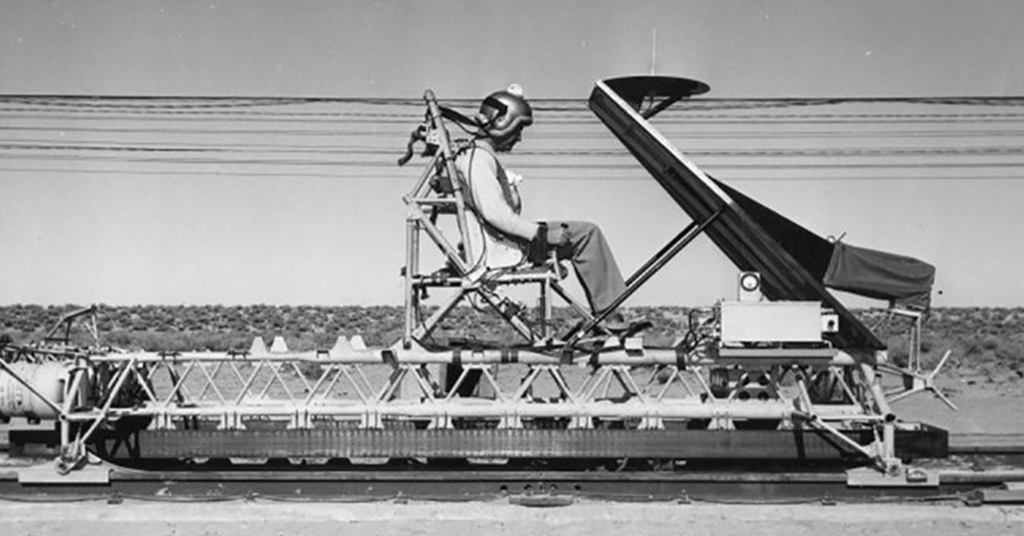By: Steven Daun, National Chief Pilot
Most people have heard of Murphy’s Law. But few people know where or how it started. The phrase “Murphy’s Law” was coined at Edwards Air Force Base in the 1940s. During this time, a group of scientists was trying to design a safe ejection seat system for pilots. One of the lead scientists was Edward Murphy. As his team connected accelerometer sensors to the test seat, he was asked if he wanted to double-check everything before the test started. He said no and just wanted to get on with the test. The technicians inadvertently connected the sensors up incorrectly, and when the test was performed, all of the readings were zero. The test was a failure. As Murphy discussed the results, he stated that “If there are two ways of doing something, and one of the ways will result in disaster, he will inevitably do it that way.”
For the next series of tests, a flight surgeon named Colonel John Stapp volunteered to ride the test sled. Stapp recognized the significance of what Murphy said early on. During an interview, he claimed that the team’s good safety record had been due to its awareness of “Murphy’s Law.” He went on to explain that “whatever can go wrong, will go wrong.”
There are two parts to Murphy’s Law. The first part addresses preparation and attention to detail, while the second part addresses the need to be ready for anything that may happen.
Since Murphy’s Law was born in aviation, it is imperative that all pilots understand its meaning and how to mitigate its impact in their flying. This is especially true in today’s world of highly automated general aviation cockpits. Many pilots have grown to rely on automation instead of using it as a tool to supplement their flying.
The inevitable personification of the law we’ll call, Mr. Murphy, loves aviation and he loves to fly in airplanes. He loves aviation because he knows that there are many pilots and mechanics who cut corners, do not take things as seriously as they should be taken, and take unnecessary chances or risks. He especially loves to fly with pilots who are running late or being chased by the weather. Remember, Mr. Murphy has been flying for over 76 years and isn’t going anywhere.
As a pilot, your job is to recognize that Mr. Murphy will always hitch a ride in your airplane. This means that you will need to stay one step ahead of him while you are flying. Proper preflight planning, proper route, and contingency planning, and always filing a flight plan are just some of the things that you can do to keep Mr. Murphy in his seat. If you fly an automated airplane, you owe it to yourself and your passengers to take some emergency training on what to do to safely fly your airplane when all of the automation has shut down.
The good news is that for the pilot who is prepared, Mr. Murphy is a great passenger. He will keep you on your toes and remind you when you start to become complacent. This is especially true when you are flying single-engine IFR at night or single-engine over the water or mountains. He communicates through funny sounds and smells, urging you to keep checking everything. If you can satisfy Mr. Murphy on a flight, you know you had a great one.
It may sound like a daunting task to “be ready for anything.” The actual phrase should be changed to read, “be ready to mitigate anything.” Just as a formula one driver spends hours studying a race track, or mission control spends weeks and months planning a space flight, you too should spend an ample amount of time planning your flight, studying the topography of your route and contingency plans in case you have an engine issue, electrical issue or if you find unexpected weather. Spend some time going through the different scenarios in your mind. The more you prepare, the more you will be ready to keep Mr. Murphy in his seat.
Find a strong instructor and spend some “anti-automation” time with them in a simulator or in your airplane. Learn how to fly your airplane solely by reference to the standby instruments, a paper chart, and an E6B. Refresh yourself on an emergency drift down. Chances are, you can even find a flight simulator at your local school that you can use to fly the flight before you actually fly the flight.
Did I mention that Mr. Murphy loves to fly in airplanes?










